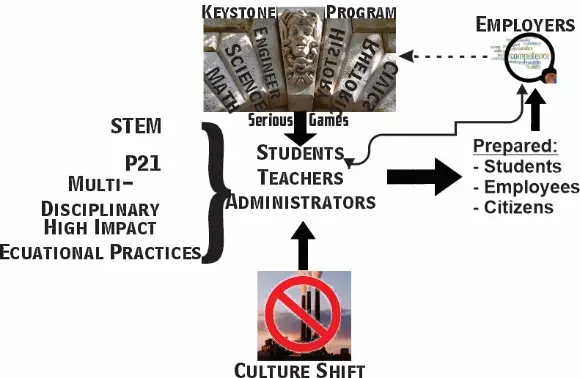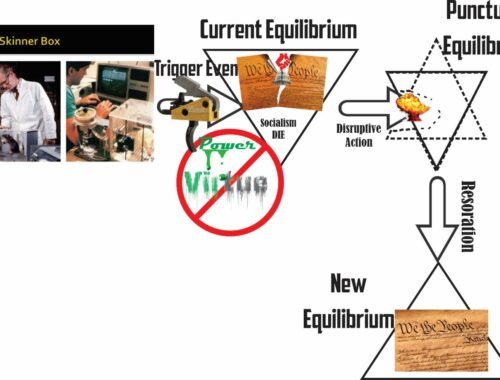
Educating Citizens versus Sheep, Part 5: The Keystone and Serious Games
I discussed the Keystone concept in Part 4 of this series and developed it in more detail in the Breaking Silos post. The Keystone concept is vital to redesigning education to meet the demands of a complex, challenging, and dynamic environment to foster creative, critical, and integrative thinking and problem solving. Serious games are the foundational component of the Keystone concept to create a learning environment that helps students to stretch their capabilities and knowledge building abilities. The breaking silos post goes into some detail.
This post and following posts will add more details than the short paper could provide. This post looks at what serious games are and are not. There is also an extensive reference list of papers on games and education at the end of this post that provide support and ideas.
When I first researched serious games for education, I thought serious games and gamification were similar concepts. I soon realized that they may be related, but are not the same.
Gamification uses badges, points, leader boards, etc. to motivate the student. As such, it is really a form of operant conditioning. As I discussed in Operant Conditioning and Conditional Expectations and Change, operant conditioning strips away intrinsic motivation and replaces it with a Pavlovian system of rewards and punishments. This is the realm of instructing sheep than educating responsible citizens. I will admit, however, that it is powerful, and Garmin’s badges motivate me to get moving when I would really like to sit around and do nothing. It is useful in the right settings, when combined with other educational tools. But by itself, we teach sheep.
Serious games are more complex and have several dimensions. They teach citizens to think critically, across disciplines and develop creative approaches to solving problems.
For example, Oxford Academic says:
“Serious games are designed to entertain and educate players, and to promote behavioral change. This chapter reviews characterizations of serious games and the theoretical perspectives, most notably Social Cognitive Theory, that have been used to account for their effects, and game elements such as identity, immersion, and interactivity.”
This definition is congruent with the effects of gamification. Niklas Henriks (Henriks, 2006, p. 3) defines them as:
“There are two fields in Serious Games, which are not mutually exclusive; Game(s) based learning (GBL) which try to harness the motivation power of games and ‘learning through doing’. The other field tries to use game engines, modified or not, as a cost effective way to visualize a problem domain or use them as parts of full blown simulations”
I am partial to Henriks’ approach as he advocates using external components and traditional game engines as the military does in its gaming approach. In this hybrid method, the game engine is used to assess the results of the decisions the players make in the planning and execution processes.
To round out a definitional approach, a paper in the University of Michigan Library states:
“Broadly defined, “a serious game or applied game is a game designed for a primary purpose other than pure entertainment. The “serious” adjective is generally prepended to refer to video games used by industries like defense, education, scientific exploration, health care, emergency management, city planning, engineering, and politics. The idea shares aspects with simulation generally, including flight simulation and medical simulation, but explicitly emphasizes the added pedagogical value of fun and competition.”
The Keystone concept incorporates these dimensions as the engine to evaluate the results of decisions the teams make and show the results. This is like the Army’s hybrid approach in the Mission Command Training Program (MCTP). There, commanders and staffs go through their normal staffing process in their command posts and do not interface directly with the game engine. Their subordinate units interact with game and provide the normal reports and information back to their higher headquarters, very much like they would in a full exercise or conflict.
In the Keystone, teams of students engage in problem-solving and decision-making in teams, learning discourse, dialog, critical thinking and creativity. The administrator then feeds results into a game engine to determine results and provide reports back to the teams. The emphasis is on the team’s interactions, analysis, and decisions, not the game. We do not want the students distracted from the learning objectives by the game.
References
Anastasiadis, T., Lampropoulos, G., & Siakas, K. (2018). Digital Game-based Learning and Serious Games in Education. International Journal of Advances in Scientific Research and Engineering, 4(12), 139–144. https://doi.org/10.31695/ijasre.2018.33016
Bartle, R., Carr, D., Dunwell, I., Egenfledt-Nielsen, S., Hoggard, J., Matthews, M., Rowlands, H., & Stidwell, P. (2010). Games in Education: Serious Games. www.futurelab.org.uk
Bertelsen, O. W. (2003). Activity Walkthrough – a cognitive walkthrough in activity theory terms. Proceedings of the Third Danish Human-Computer Interaction Research Symposium, 98, 17–20. http://userportal.iha.dk/~sw/kurser/brga_04/Litteratur/SigCHI_DK_proceedings/2003.pdf#page=91
Bogatinov, D., Angelevski, S., & Trajkovik, V. (2011). Model of firearms simulator based on a serious game and sensor technology. In Proceedings of the European Conference on Games-based Learning (Vols. 2011-Janua, Issue October).
Borge, M., & White, B. (2012). Supporting STEM learning with gaming technologies: Principles for effective design. AAAI Workshop – Technical Report, WS–12–17, 44–50.
Brewer, L., & International Labour Office, Skills and Employability Department.”. (2013). Enhancing Youth Employability: What? Why? and How?
Chandross, D., & Decourcy, E. (2018). SERIOUS GAMES IN ONLINE LEARNING. In International Journal on Innovations in Online Education (Vol. 2, Issue 3). www.begellhouse.com
Cheng, M.-T., Chen, J.-H., Chu, S.-J., & Chen, S.-Y. (2015). The use of serious games in science education: a review of selected empirical research from 2002 to 2013. Journal of Computers in Education, 2(3), 353–375. https://doi.org/10.1007/s40692-015-0039-9
Chung, G. K. W. K. (2015). Guidelines for the design and implementation of game telemetry for serious games analytics. In Serious Games Analytics: Methodologies for Performance Measurement, Assessment, and Improvement (pp. 59–79). Springer International Publishing. https://doi.org/10.1007/978-3-319-05834-4_3
Connolly, T. M., Boyle, E. A., MacArthur, E., Hainey, T., & Boyle, J. M. (2012). A systematic literature review of empirical evidence on computer games and serious games. Computers and Education, 59(2), 661–686. https://doi.org/10.1016/j.compedu.2012.03.004
Cruz-Cunha, M. M. (2012). Handbook of research on serious games as educational, business and research tools. Information Science Reference.
de Freitas, S., & Liarokapis, F. (2011). Serious Games: A New Paradigm for Education? In Serious Games and Edutainment Applications (pp. 9–23). Springer London. https://doi.org/10.1007/978-1-4471-2161-9_2
De Gloria, A., Bellotti, F., & Berta, R. (2014). Serious Games for education and training. International Journal of Serious Games, 1(1). https://doi.org/10.17083/ijsg.v1i1.11
De Gloria, A., Bellotti, F., & Berta, R. (2014). Serious Games for education and training. International Journal of Serious Games, 1(1). https://doi.org/10.17083/ijsg.v1i1.11
DeVane, B., & Squire, K. D. (2012). Activity Theory in the Learning Technologies. Theoretical Foundations of Learning Environments, 242–267.
Dicerbo, K. (2015). Taking Serious Games Seriously in Education. EDUCAUSEreview, 1–4. http://www.educause.edu/ero/article/taking-serious-games-seriously-education?utm_source=Informz&ut
Ebner, M., & Schiefner-Rohs, M. (2010). Looking toward the future of technology-enhanced education : ubiquitous learning and the digital native. Information Science Reference.
Fabricatore, C. (2019). Underneath and Beyond Mechanics An Activity-theoretical Perspective on Meaning-making in Gameplay. Games and Rules, 87–112.
Fanfarelli, J. (2014). The Effects of Narrative and Achievements on Learning in a 2D Platformer Video Game. https://stars.library.ucf.edu/etd/4772
Fernández Galeote, D., & Hamari, J. (2021). Game-based Climate Change Engagement: Analyzing the Potential of Entertainment and Serious Games. Proceedings of the ACM on Human-Computer Interaction, 5(CHIPLAY). https://doi.org/10.1145/3474653
G-Cube Webwide Software Pvt Ltd. (2016). 5 Game Elements That Create Effective Learning Games. Https://Elearningindustry.Com/5-Game-Elements-Create-Effective-Learning-Games.
Girard, C., Ecalle, J., & Magnan, A. (2013). Serious games as new educational tools: How effective are they? A meta-analysis of recent studies. Journal of Computer Assisted Learning, 29(3), 207–219. https://doi.org/10.1111/j.1365-2729.2012.00489.x
Harteveld, C., Guimarães, R., Mayer, I., & Bidarra, R. (n.d.). Balancing pedagogy, game and reality components within a unique serious game for training levee inspection.
Henriks, N. (2006). Institutionen för kommunikation och information Examensarbete i datavetenskap 20p (kursnamn+poäng) C-nivå Creating Serious Games by integrating external components in commercial game engines Propositions and guidelines for future work with serious games.
Hung, A. C. Y. (2017). A critique and defense of gamification. Journal of Interactive Online Learning, 15(1), 57–72.
Iten, N., & Petko, D. (2016). Learning with serious games: Is fun playing the game a predictor of learning success? British Journal of Educational Technology, 47(1), 151–163. https://doi.org/10.1111/bjet.12226
Jacobs, R. S. (2021). Winning over the players: Investigating the motivations to play and acceptance of serious games. Media and Communication, 9(1), 28–38. https://doi.org/10.17645/MAC.V9I1.3308
Kaptelinin, V., & Nardi, B. A. (1997). Activity theory: Basic concepts and applications. Conference on Human Factors in Computing Systems – Proceedings, 22–27–Marc, 158–159. https://doi.org/10.1145/1120212.1120321
Kara, N. (2021). A systematic review of the use of serious games in science education. Contemporary Educational Technology, 13(2), 1–13. https://doi.org/10.30935/cedtech/9608
Khowaja, K., & Salwah Salim, S. (n.d.). DESIGN COMPONENTS FOR SERIOUS GAMES OF CHILDREN WITH AUTISM SPECTRUM DISORDER (ASD).
Kühn, S., Gallinat, J., & Mascherek, A. (2019). Effects of computer gaming on cognition, brain structure, and function: A critical reflection on existing literature. Dialogues in Clinical Neuroscience, 21(3), 319–330. https://doi.org/10.31887/DCNS.2019.21.3/skuehn
Laine, T. H., & Lindberg, R. S. N. (2020). Designing Engaging Games for Education: A Systematic Literature Review on Game Motivators and Design Principles. IEEE Transactions on Learning Technologies, 13(4), 804–821. https://doi.org/10.1109/TLT.2020.3018503
Marsh, T., Wong, W. L., Carriazo, E., Nocera, L., Yang, K., Varma, A., Yoon, H., Huang, Y. L., Kyriakakis, C., & Shahabi, C. (2005). User experiences and lessons learned from developing and implementing an immersive game for the science classroom. International Conference on Human-Computer Interaction.
Marsh, T. (2010). Activity-based scenario design, development and assessment in serious games. In R. Van Eck (Ed.), Gaming and Cognition: Theories and Practice from the Learning Sciences (pp. 213–226). https://doi.org/https://doi.org/10.4018/978-1-61520-717-6.CH010
Marsh, T., & Nardi, B. (2014). Spheres and lenses: Activity-based scenario / narrative approach for design and evaluation of entertainment through engagement. Lecture Notes in Computer Science (Including Subseries Lecture Notes in Artificial Intelligence and Lecture Notes in Bioinformatics), 8770, 42–51. https://doi.org/10.1007/978-3-662-45212-7_6
Marsh, T., & Nardi, B. (2016). Narrative in HCI : Interactions , Play , Games , Stories , Fictions and Envisioning Futures Using Activity Theory. April 2015.
Marsh, T., Yang, K., & Shahabi, C. (2006). Game development for experience through staying there. Proceedings – Sandbox Symposium 2006: ACM SIGGRAPH Video Game Symposium, Sandbox ’06, 83–89. https://doi.org/10.1145/1183316.1183327
Mcmahon, M. (2008). A Model of Immersion to Guide the Design of Serious Games Assessing Executive Functions and Problem-Solving in Primary School Students View project. https://www.researchgate.net/publication/49277587
MOKEDDEM, A., PLAISENT, M., & PROSPER, B. (2019). Learning with the Games: a Competitive Environment based on Knowledge. Journal of E-Learning and Higher Education, 2019, 1–6. https://doi.org/10.5171/2019.133016
Nguyen, T. (2016). Serious games. Significance, 13(6), 14–19. https://doi.org/10.1111/j.1740-9713.2016.00978.x
Paper, C. (2014). Informing Design and Evaluation Methodologies for Serious Games for Learning Informing Design and Evaluation Methodologies for Serious Games for Learning. January 2007.
Pellegrino, J. W., & Hilton, M. L. (2013). Education for life and work: Developing transferable knowledge and skills in the 21st century. In Education for Life and Work: Developing Transferable Knowledge and Skills in the 21st Century. https://doi.org/10.17226/13398
Pontual Falcão, T., Mendes de Andrade e Peres, F., Sales de Morais, D. C., & da Silva Oliveira, G. (2018). Participatory methodologies to promote student engagement in the development of educational digital games. Computers and Education, 116, 161–175. https://doi.org/10.1016/j.compedu.2017.09.006
Poplin, A. (2012). Playful public participation in urban planning: A case study for online serious games. Computers, Environment and Urban Systems, 36(3), 195–206. https://doi.org/10.1016/j.compenvurbsys.2011.10.003
Putra, P. D. A., & Iqbal, M. (2016). Implementation of serious games inspired by baluran national park to improve students’ critical thinking ability. Jurnal Pendidikan IPA Indonesia, 5(1), 101–108. https://doi.org/10.15294/jpii.v5i1.5798
Revillion, M., Dussaix, E., Giraud, M., Liberpre, C., Couturier, E., & Astagneau, E. D. (2007). 2006 a a. 2006(October 2006), 4–8.
Siang Ang, C., & Zaphiris, P. (2008). Social learning in MMOG: An activity theoretical perspective. Interactive Technology and Smart Education, 5(2), 84–102. https://doi.org/10.1108/17415650810880754
Stege, L., Van Lankveld, G., & Spronck, P. (n.d.). Serious Games in Education. www.iacss.org
Trevathan, M., Peters, M. L., & Willis, J. (n.d.). Serious Games Classroom Implementation: Teacher Perspectives and Student Learning Outcomes. https://www.researchgate.net/publication/301265935
Van Der Vegt, W., Westera, W., Nyamsuren, E., Georgiev, A., & Ortiz, I. M. (2016). RAGE Architecture for Reusable Serious Gaming Technology Components. International Journal of Computer Games Technology, 2016. https://doi.org/10.1155/2016/5680526
Vicuna, L. (2017). Educational Games Design : Creating an Effective and Engaging Learning Experience. https://www.theseus.fi/bitstream/handle/10024/122686/final_draft.pdf?sequence=1
Wattanasoontorn, V., Hernández, R. J. G., & Sbert, M. (2014). Serious Games for e-Health Care (pp. 127–146). https://doi.org/10.1007/978-981-4560-32-0_9
Wayne Bretherton, G. S. and J. C. R. (2016). Abstracts of the Papers Presented at the 10th European Conference on Games Based Learning Hosted by The University of the West of Scotland Paisley. Abstracts of the Papers Presented at the 10th European Conference on Games Based Learning Hosted by The University of the West of Scotland Paisley.
Westera, W., Prada, R., Mascarenhas, S., Santos, P. A., Dias, J., Guimarães, M., Georgiadis, K., Nyamsuren, E., Bahreini, K., Yumak, Z., Christyowidiasmoro, C., Dascalu, M., Gutu-Robu, G., & Ruseti, S. (2020). Artificial intelligence moving serious gaming: Presenting reusable game AI components. Education and Information Technologies, 25(1), 351–380. https://doi.org/10.1007/s10639-019-09968-2
Westera, W., Van Der Vegt, W., Bahreini, K., Dascalu, M., & Van Lankveld, G. (n.d.). Software Components for Serious Game Development.
Wilhelmsson, U., Susi, T., & Torstensson, N. (2021). Merging the analogue and the digital: Combining opposite activities in a mixed media game. Media and Communication, 9(1), 17–27. https://doi.org/10.17645/MAC.V9I1.3203
Wilson, D. W., Jenkins, J., Twyman, N., Jensen, M., Valacich, J., Dunbar, N., Wilson, S., Miller, C., Adame, B., Lee, Y. H., Burgoon, J., & Nunamaker, J. F. (2016). Serious games: An evaluation framework and case study. Proceedings of the Annual Hawaii International Conference on System Sciences, 2016–March, 638–647. https://doi.org/10.1109/HICSS.2016.85
Serrano-Laguna, Á., Martínez-Ortiz, I., Haag, J., Regan, D., Johnson, A., & Fernández-Manjón, B. (2016). Applying standards to systematize learning analytics in serious games. Computer Standards and Interfaces, 50, 116–123. https://doi.org/10.1016/j.csi.2016.09.014
Fabricatore, C., & Lopez, M. X. (2019). Game-based learning as a meaning making-driven activity process: a human perspective. In Proceedings of the 13th International Conference on Game Based Learning ECGBL 2019 (pp. 218–226). Academic Conferences and Publishing International. https://doi.org/10.34190/GBL.19.177





